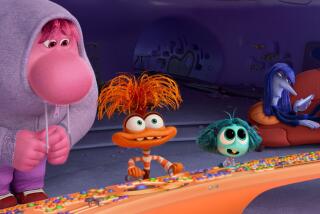COLOR THE BOTTOM LINE GREENISH
- Share via
The one central, eternal, irrevocable, irresistible, double-dyed, double-stitched, copper-riveted, shrink-resistant, inescapable, certain truth about motion pictures and television is that they are marketplace commodities.
They are subject to the iron laws of supply and demand, profit and loss, obsolescence and innovation, popularity and indifference and of quality and artfulness as they may affect business.
They are commerce founded upon what has proved to be an art form, but they still answer to the laws of commerce, whatever passionate idealism sometimes informs the making of the art.
Public television and public radio try to sidestep the marketplace, but they get little more than a half-step away, as anyone knows who endures the water torture of pledge weeks or catches the expanding acknowledgements to the corporate sponsors. Public television in particular has become ever more concerned about, and occasionally boastful about, its ratings and market shares, just like the big guys.
And the bottom line of the present furor over coloring black-and-white movies and old television for present television and cassettes is--beneath the cover of aesthetic outrage--that old debbil, the bottom line.
More money, and very likely quite a lot more money, is going to be made off the labors (the ancient labors, in some cases) of men and women who are not going to see a penny of it.
It was ever so with painters and sculptors after the first sale of their work (despite schemes that would cut them in for a slice of subsequent, fatter sales of the same work). But residuals and royalties, wrenched out of the producing companies by long, hard struggle, are an important item in movies and television, as they are in music.
It is quite as if an unexpected pie had been found in the pantry, and the question now raised is about who--if anybody--in the creative community gets a slice of it.
Legally, the questions are boggling. Is a new copyright created in the new, colored version of black-and-white material? Are there grounds for preventing the coloring of existing material? A movie contains all kinds of rights: first-run, subsequent-run, domestic, foreign, commercial television, cable television, 16-millimeter film, cassettes. Where does coloring fit in, notably for those films that are not yet in the public domain?
Lawsuits have been filed; more will be. The cholers over color are so hot that public relations firms, eschewing a fat fee, are tiptoeing away from the defense of the colorizers.
There are, of course, legions of us who are appalled at the thought of certain classic films, like “The Grapes of Wrath” and “Casablanca” and “Citizen Kane,” being colored.
To a class at USC the other night, the fine young French director Bertrand Tavernier (“Round Midnight”), a lifelong student of American movies, cried that every time film journalists had to print the name of Ted Turner they should deliberately misspell it, as a symbol of his distortion of the 100 films he is having colored.
The countering arguments are that the coloring processes work only for tape, for television or cassette use; the theatrical versions will remain available and intact.
Also, it is said, we traditionalists can always crank down the color knob on our sets and see the films in black and white. But in shades of gray is more like it, from my experience of watching color on black-and-white sets.
There is simply no way the deep blacks and crisp and snappy white of classic black-and-white cinematography--the chiaroscuro that was the hallmark of the Warner Bros. films of the ‘30s for example--will survive an overlay of electronic color.
A principal argument for coloring is that present audiences, especially young audiences, won’t watch black-and-white television. It is counterargued that some very popular MTV’s have been done in black and white, and that young film buffs will be as indignant as their elders at Charles Foster Kane with brown hair, blue eyes and a pink complexion.
But the hard fact is that there is, and always has been, more mediocre and bad art than good art, for every “Kane” a hundred dozen dimwitted program pictures (at least) to fill the double bills. Some of these have acquired a certain charm in their sheer awfulness, and some are encrusted with private memories of I-saw-it-when. But as shrines for later aesthetic worship, I think not.
One of the films being colored at the moment is the Shirley Temple “Heidi,” directed by the admirable Allan Dwan and photographed by Arthur Miller, who did “How Green Was My Valley” and other visually outstanding films commencing in silent days.
In a side-by-side test of a good black-and-white tape versus the colored footage (which I had expected to find on a par with those hand-tinted family portraits of yesteryear), it was hard not to opt for blue mountain skies over pale gray skies, and for green pines over darker gray pines. The quality of the color was surprisingly good, although it can vary tremendously, depending on how many of television’s 30 frames per second the processors color individually.
As between preserving a historical artifact for the appreciation of film buffs and creating a new audience, which might not otherwise be found, for a classic children’s story, it seemed to me to be no real contest. And the film artifact presumably is preserved.
The case for color as a resuscitator of dead product is even firmer with early television stuff, which was black and white by necessity and not distinguished as such. No one (I hope) would argue that black and white is sacred to Abbott and Costello.
Movies are another matter, and it is beyond doubt that the best black-and-white films, converted to color, will lose their integrity, their intensity and their atmospheric power. In these films, the black and white was not just the medium, it was part of the message.
Incidentally, I feel about the word colorize as E. B. White felt about the word personalize . He once wrote that he would as soon Simonize his grandmother as personalize his writing. Colorizing a film seems to me in a league with rinsizing your clothes or ironizing your pants, but I guess it sounds impressive.
But outrages not withstanding, the coloring of films is likely to be part of our future, as unavoidable as most technological change. What is specifically done, or not done, will come down to choices by the customers. If a colored version of “The Maltese Falcon” is an abomination, the customers will eschew it in bulk.
The matter, that is, will end up in the marketplace, as Ted Turner will have said all along.


